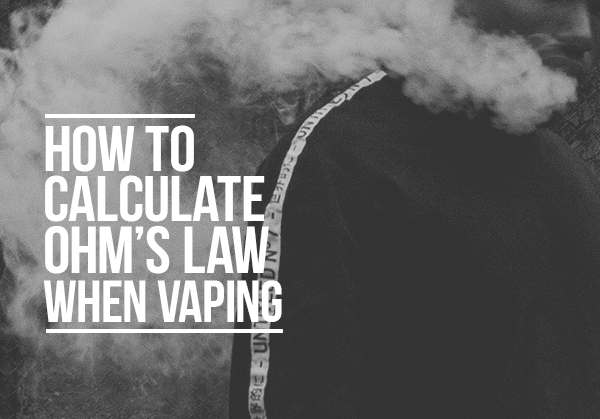Kick the Crave
How Vapers Can Calculate Ohm’s Law When Vaping
As DIY vaping becomes increasingly popular, more users are relying on internet calculators in order to determine whether or not their coil builds can be safely used with their vaping setup. These calculators depend on Ohm’s Law, a small group of mathematical formulas that are designed to determine the proper level of ohms for any given output level.
It can’t be doubted that these calculators really come in handy, especially for those very new to the world of coil-building who are particularly paranoid about vaping dangerously. However, we firmly believe that vapers of all levels owe it to themselves to know how Ohm’s Law works in order to gain a better understanding of vaping technology.
The Creation of Ohm’s Law
It’s understandable that many vapers believe that Ohm’s Law was created for vape-related purposes. After all, most vape enthusiasts aren’t experienced electricians or professional mathematicians. Therefore, a good number of vapers have never even heard of this phrase until they started taking interest in the idea of building their own vape coils.
However, Ohm’s Law dates back to 1827, long before vaping was around, not to mention household electronic devices. George Ohm, born in Germany in 1727, was a mathematician who set out to discover the way in which electrical circuits are heated. In 1827, he published a report that demonstrated the mathematical relationship between current, resistance and voltage. Consisting of a group of formulas, it became known as Ohm’s Law.
George Ohm’s discovery was so influential on the future of electronics that he was awarded the Copley Medal in 1841. The word “ohm” came to represent a single unit of electrical resistance shortly after. To this day, Ohm’s Law is a crucial part of electrical studies and is used in a wide range of industries.
How Ohm’s Law Works
Basically, Ohm’s Law demonstrates that the current and voltage are directly proportional to each other for any given resistance level. In the case of vape coils that come in a wide array of resistance levels, the current level can vary tremendously. Meanwhile, the resistance level goes down the higher the current and voltage levels.
Ohm’s Law exists as a mathematical triangle. Voltage is at the top of the triangle, with current and resistance being next to each other on the bottom. The triangle demonstrates the mathematical equations that must be performed in order to determine the current, voltage or resistance level required.
Determining Resistance Level
When building your coils, you need to choose a resistance level that’s compatible with your output level. In order to determine the proper resistance level for your output levels, the calculation is voltage divided by current. This calculation is useful for anyone who uses a vape battery that maintains a fixed voltage level.
Let’s say that you’re using vape batteries that have a voltage of 4.2 volts and a current of 20 amps. We can easily conclude that the resistance level required would be .021 ohms. This means that the coil that will function the best (and be the safest) would be a 0.21ohm coil.
Determining the Voltage Level
Now, you can probably see how the formula is rearranged in order to come with the ideal voltage level for a specific combination of coil resistance level and current. Obviously, it’s not nearly as likely that you’ll have to determine the voltage anytime soon as vape batteries have a fixed voltage level. Still, in order to demonstrate the beauty of Ohm’s Law, we’re going to dive into it anyway.
Simply put, voltage is current multiplied by resistance. Therefore, using our example before, if we use a 0.21ohm coil with a current level of 20 amps, the voltage level is going to be 4.2 volts.
Determining the Current Level
Simply put, current is voltage divided by resistance. Because vape batteries have limits on currents, it’s very important to know this formula. If your current level is too high as a result of the resistance level you’re using, you’re putting yourself at risk of damaging your device or even yourself. We really can’t stress enough the importance of knowing the maximum current level of your vape batteries.
If the vape battery is at 4.2 volts and you’re using a .25ohm coil, you’d simply divide 4.2 by 0.25, ending up with a current level of 16.8 amps. As long as your battery can withstand that, you’re in the clear.
Determining the Wattage Level
You’ve probably noticed that wattage is absent from Mr. Ohm’s triangle. However, the formula is incredibly simple and falls in line with Ohm’s Law perfectly.
In order to determine the ideal wattage level for your particular coil, simply multiply voltage by current. This means that if your battery is at 4.2 volts and has a current of 20 amps, the wattage should be 84 watts. From there, you can use Ohm’s Law to conclude that as the wattage level increases, the coil’s resistance level decreases.
The Importance of Using Ohm’s Law
Ohm’s Law isn’t just beneficial to those who build their own coils. If you’re completely new to the world of vaping, this group of formulas is incredibly handy. It can help you determine the perfect wattage to use with your new coil. It can also help you select the very best coil for your vape batteries. Besides keeping you and your hardware safe, these formulas can make it much easier to find your sweet spot. After all, those who are totally new to vaping tend to find themselves guessing as they go along.
However, Ohm’s Law is basically essential if you are building your own coils. You could easily blow out your battery or cause it to combust if you’re not taking these formulas into consideration while creating new coil configurations. As we said earlier, you can use an online calculator, however, these formulas are simple enough that you can do the math yourself.
Next Time You Build a New Vape Coil…
Now that you understand how Ohm’s Law works and how it originated, we hope that you have a stronger appreciation for the mathematical side of vaping and use it responsibly.










